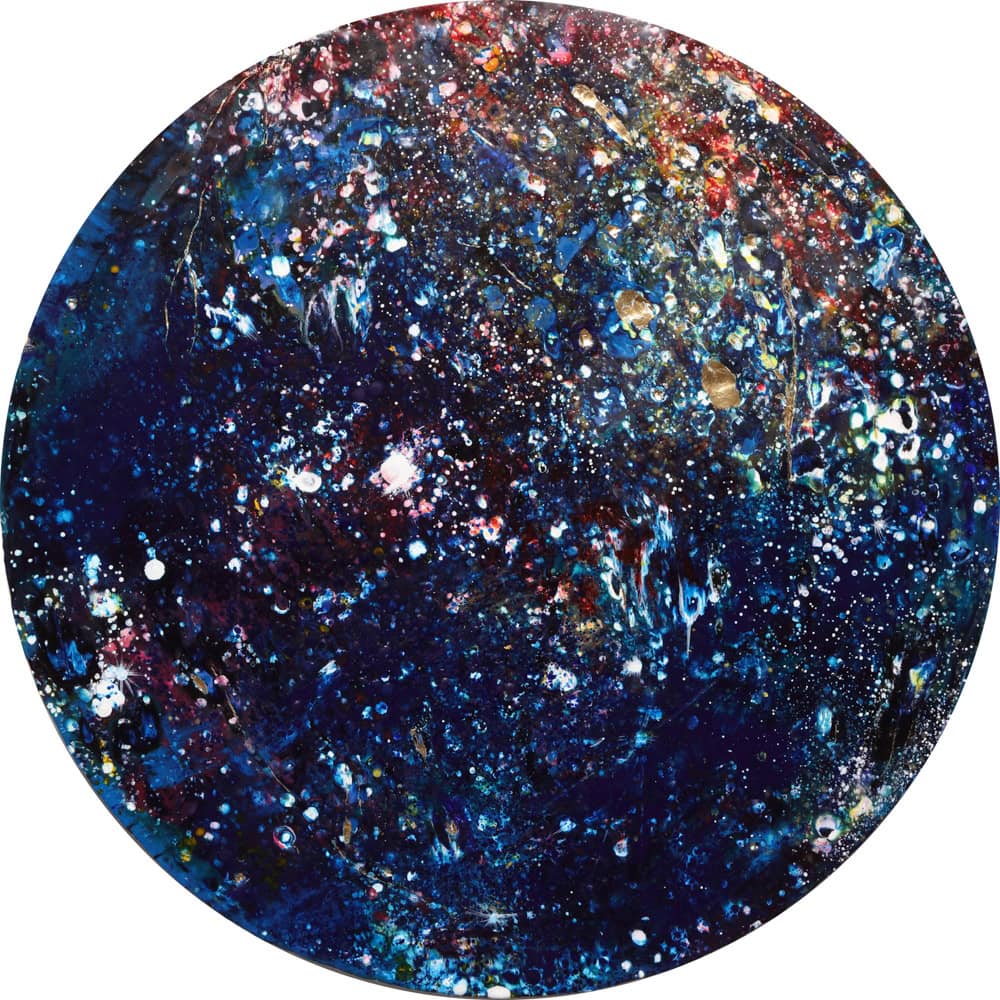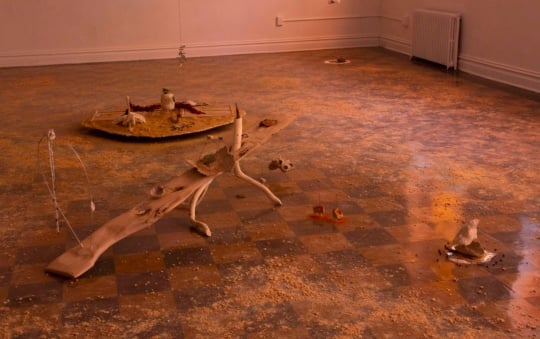
Astronomical images have saturated popular consciousness in the post-Hubble decades. In doing so, they have spurred the creation of art that draws on these ever more far-reaching visualizations. Witness, for example, the weaving of cosmological photographs into the work of artists as different as Vija Celmins, Jack Goldstein, Thomas Ruff, and Jonathan Feldschuh. They belong to a broader trend of artists evincing a fascination with scientific images, concepts, and technology. Michele Schuff’s “On the Edge of Forever,” on view at Sandler Hudson Gallery through March 17, falls within this tradition, sharing its typical themes and preoccupations, its characteristic visual strategies, and, unfortunately, some of its confusion about what art wants from science.
Schuff’s works merge astronomically inspired pictures with thoroughly terrestrial materials. She works mainly in encaustic, and the texture of her surfaces varies from shiny, smoothed out waves through irregular bubbles and pockmarks to deep gouges and cracks. Many of the works have chips of shiny black stone, flakes of mirror, or silvery paint embedded in them. The results are neither clearly legible as images nor as purely sculptural objects, but something in between. The overall impression they give is of something more mineral than celestial, like bits of the sky fallen and fossilized, studded with the bones of old light.

In terms of visual strategy, the works (most dated 2018) combine this surface-level grittiness with a vocabulary grounded in the conventions of abstract mark-making: densely layered blots of color, alternating with blurred and smeared passages. A few resemble images of the objects they are named for. Most obviously this is true for the large tondo Moone (2017), but the smaller Callisto (Blue) and Ganymede’s Dream are modeled on the Jovian satellites, and Abell 2744 very roughly approximates a galactic cluster. Others, though, offer only more vaguely identified references. Jupiter, Storm, for example, with its waxy blue concentric wave patterns, bears more resemblance to an impressionistic acid-trip vision than any atmospheric phenomenon found on the gas giant. Similar gooey swirls recur in Ganymede’s Dream.

Questions that inevitably arise in art that leans so heavily on scientific source material is just how much of the science itself enters into the work, and to what end. This is an absolutely central problem that needs to be faced (but frequently isn’t) by all varieties of “sci-art.” It’s notable that within astronomy and astrophysics images like the ones that Schuff draws on play a marginal role; often they are just pretty pictures created mainly for public consumption. Works like these, then, offer something closer to a half-remembered dream of science rather than a sustained engagement with its processes and products. In this I think they differ from Celmins’s meticulously constructed star fields, or Goldstein’s vivid yet cold airbrush paintings, both of which are responding to the new visual conditions created by photographic and scientific imaging. Nor is Schuff working directly with the numerical data that underlies these images, as in Feldschuh’s massive visualization projects.
Schuff has remarked that her aim is for these works to conjure awe, to recall a sense of our own smallness and frailty relative to the cosmos. But awe, like the sublime, is linked with what overflows our perceptual abilities and confronts them with their own limitations. And wonder, historically, denotes that which lies beyond the realm of scientific or rational understanding. Neither seems well-suited to these images. Part of the difficulty is that, I suspect, we are too familiar with the look of prettified stellar pictures. Science fiction films and NASA’s public relations wing have made them into tame, familiar elements of our visual world. Hence it is no longer sufficient to uncritically present the subjects historically associated with the sublime – things vast, distant, and ancient – as if they were still self-evidently capable of evoking feelings like wonder and awe. This version of the technoscientific sublime is an affect that is being kept alive on life support within much of the sci-art tradition. It has little independent existence of its own.
Seeing celestial objects through a filter of contemporary abstract techniques is a way of diminishing them, of avoiding seeing them for what they really are. The vast scale and distance of a galactic cluster, capable of being conveyed with such numerical precision, evaporates when it is visually embodied in a broken and blurred form. In the end, then, I am not sure whether these works have fully conceptualized their own relationship to their astronomical source material. At least this relationship strikes me as being incompletely resolved. It is worth trying instead to look at these works in a way that is liberated from the dead grip of notions like wonder. Their scratched and pockmarked surfaces give them a primitive look, and this makes it most tempting to read them as attempts to break the science, unseating its authority by ruining its normally glossy, high-tech productions. Viewed this way, they betray a kind of aggression, a way of dragging scientific visualization down to earth, into the muddy substance itself. It is anything but awe.
Dan Weiskopf is an associate professor of philosophy and an associate faculty member in the Neuroscience Institute at Georgia State University. He is the author, with Fred Adams, of An Introduction to the Philosophy of Psychology (Cambridge University Press).




